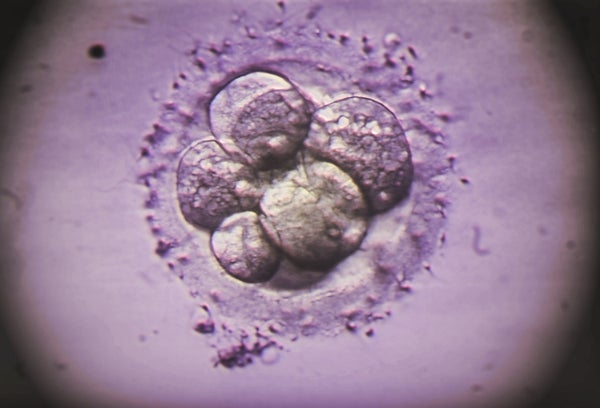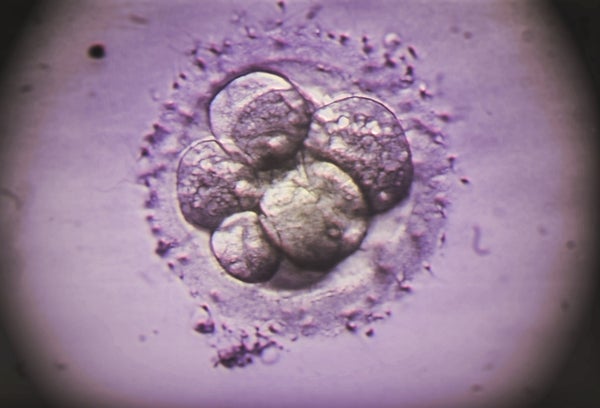
[ad_1]
Alabama’s Embryo Personhood Decision Threatens Patients, Medicine and Advances in IVF
A state court ruling that embryos from in vitro fertilization are unborn children harms access to care for fertility patients, as well as medical innovations

IVF embryo. Colored light micrograph of a human embryo 48-72 hours after in vitro fertilization (IVF). At this stage an embryo typically consists of between 4-8 cells.
Zephyr/Science Source
Alabama’s Supreme Court ruled in February that frozen embryos from in vitro fertilization (IVF) are considered “unborn children.” The decision allowed for lawsuits when the loss of an embryo was caused by “the wrongful act, omission, or negligence of any person.”
In the days following this decision, my community—infertility and cancer patients in the privacy of exam rooms here in California, the clinical team caring for them, scientists and policy makers working on innovations to improve fertility care, and medical trainees drawn to reproductive justice and learning advocacy—expressed dismay, fear, confusion and outrage.
That’s because this ruling hurts patients, equitable access to care, and medical advancements in fertility both now and in the future. The reasons are clear to anyone who understands the reality of infertility treatment.
On supporting science journalism
If you’re enjoying this article, consider supporting our award-winning journalism by subscribing. By purchasing a subscription you are helping to ensure the future of impactful stories about the discoveries and ideas shaping our world today.
IVF is the cornerstone of infertility and fertility preservation treatments. A conservative estimate is that one in five people will experience infertility. In addition, young people who face medical treatments that can cause infertility also use fertility preservation services to give them reproductive options in the future.
IVF shows the potential for eggs and sperm to join and grow through various stages of embryo development. But it also shows why human reproduction is biologically inefficient; decades of research reveal that not every egg successfully fertilizes with sperm, not every fertilized egg continues to develop into a blastocyst embryo, not every blastocyst embryo implants in the uterus to grow into a fetus, and not every fetus continues to birth, no matter how good current technology is or how much patients and clinicians wish for this outcome. These observations align with the roughly 20 percent chance of pregnancy in a month when a heterosexual couple first tries to become pregnant and the 31 percent risk of miscarriage. Most miscarriages occur before a pregnant person knows that they are pregnant.
IVF is an exciting field fueled by scientific innovation and early uptake to overcome these biologic inefficiencies, treat disease and preserve fertility options. For example, intracytoplasmic injection of sperm into eggs enables males with very few sperm to become biologic parents; embryo biopsy and genetic testing enables families to prevent transmission of serious disease to their offspring by choosing not to implant embryos that carry genetic abnormalities. Within a culture of early uptake of innovations, patients and providers make shared but varied decisions about interventions that involve embryos.
In the short term, if wrongful death claims can be raised on decisions made regarding embryos, then clinicians and patients face risk of both criminal and civil liability. If a laboratory changes embryo culture conditions (or chooses not to) in response to new research, for instance, would it be liable for wrongful death for any embryos do not grow? If a patient chooses not to transfer an embryo with a chromosome abnormality that most certainly results in a neonatal death, would this patient and her clinical team be deemed as causing a wrongful death? In the aftermath of this ruling, we lose the ability to personalize IVF treatment for each patient’s needs.
In Alabama, we have empirical evidence that patients lost access to care following this decision. In the short term, IVF centers and embryo transportation services halted care immediately. Patients who wished to transport their embryos to another state could not reliably do so because clinical programs could not take on the liability for wrongful death. Public outcry led to passage of legislation in Alabama in March shielding individuals providing or receiving IVF services from criminal and civil lawsuits. But not all clinics and associated service providers resumed care amidst the uncertainty and a lack of clarity over what other legal implications arise on frozen embryos that are considered children.
In the medium term, a shortage of reproductive endocrinology and infertility specialists, nurses, embryologists will persist, exacerbated by this ruling. We need an estimate of nearly seven times more board-certified reproductive endocrinology and infertility specialists in the U.S. than the current 1,250 in practice. The context in which clinical teams and scientists in Alabama now find themselves will render it difficult to attract learners to reproductive endocrinology and infertility programs, champion scientific and clinical innovation and retain their workforce. Notably, following the Dobbs decision, states with strict abortion laws saw fewer applicants to obstetrics and gynecology training programs. Without clinical providers, disparities in access to quality care will be amplified. People who cannot afford to travel out of state for weeks of care will disproportionately lose out on building the family they hoped for.
In the long term, this ruling compounds the myriad of U.S. policies that impede scientific progress in reproductive biology and women’s health, including the 1996 Dickey-Wicker Amendment that prohibits the use of federal funds to support human embryo research. In the amendment’s aftermath, human embryo research, from efforts to prevent pregnancy loss by understanding early development to learning how best to culture embryos to support the development of health IVF offspring, was deprived of not only a critical source of funding for biomedical research in the U.S., but also robust support and peer review from the NIH. What if research funding opportunities decrease if funders are, or perceive that they are, at risk of accusations of wrongful deaths of embryos? What if scientists cannot innovate in this field, and patients choose not to participate in research that improves fertility when it involves embryos? The disparity in research on women’s health will further grow. We will stay stagnant or, worse, regress in supporting future fertility.
IVF patients experience intense joy, hope, heartbreak, financial hardship, challenging decision-making and stress. As a clinician, I have the unparalleled privilege of walking alongside our patients in this journey. As a scientist, I see the gaps in our knowledge of early embryo development and how to intervene in it for human health. I want to partner with patients, providers and scientists to use rigorous scientific inquiry to solve these gaps.
The Alabama Supreme Court ruling hurts patients, families and the medical and scientific teams supporting them. It also deters the progress that has been made to improve human health and cure disease. This is a call for awareness of the implications of this decision and others that may follow. Because of the heterogeneity in state laws, judicial cases and downstream implementation of these health policies, we need federal legislation to protect fertility treatments and the people who need them.
This is an opinion and analysis article, and the views expressed by the author or authors are not necessarily those of Scientific American.
[ad_2]